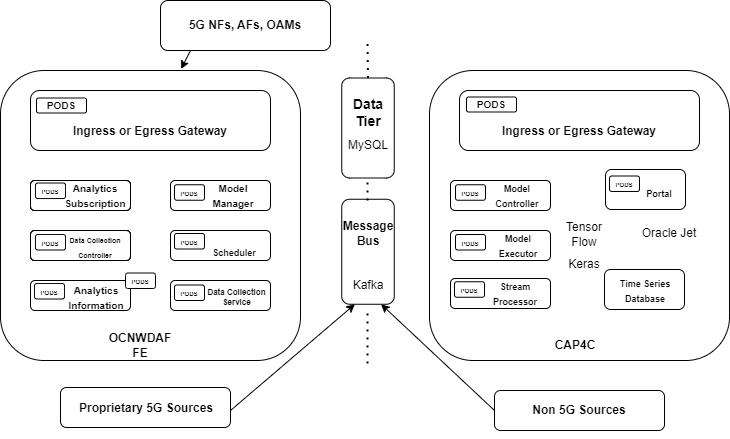2 OCNWDAF Architecture
This chapter describes the OCNWDAFs detailed design and architecture.
2.1 Oracle Communications Networks Data Analytics Function Architecture
OCNWDAF comprises of various microservices deployed in a Kubernetes based Cloud Native Environment (CNE, example: OCCNE). The environment provides some common services such as logs or metrics data collection, analysis, graphs or charts visualization, and so on. The OCNWDAF uses standard interfaces from the Service Based Architecture (SBA) to collect data through subscription or request model from other network functions.
The microservices integrate with the environment and provide the necessary data.
The OCNWDAF architecture is depicted in the diagram below:
Figure 2-1 OCNWDAF Architecture

OCNWDAF Front End
- Collects data from 5G NFs
- Provides the data to backend CAP4C
- Collects the processed analytics information from CAP4C
- Provides the analytics information to the consumer NFs and AFs
Converged Analytics Platform for Communication (CAP4C)
- Processes data from the Front End (FE)
- Examines streaming data in real time to enable thresholding and other uses
- Implements OCNWDAF analytics information (Statistical, Predictive, and Abnormal Behavior)
- Automates machine learning models
- Provides visualization and reports
2.2 Oracle Communications Networks Data Analytics Function Detailed Design
The following diagram depicts the detailed design of OCNWDAF:
Figure 2-2 OCNWDAF Design

The OCNWDAF architecture aligns with 3GPP Release 16 but supports some common features in Release 17 such as Slice Load Level Analytics, Network Performance Analytics, NF Load Analytics, and so on.
OCNWDAF Front End
The OCNWDAF Front End (FE) interacts with 5G NFs to gather information through the Service Based Architecture (SBA) or Service Based Interface (SBI) as defined in 3GPP TS 23.288 and TS 29.520.
Following are the specialized OCNWDAF microservices:
Note:
Some common services are described below. The common services are also used by other 5G NFs along with OCNWDAF.Ingress Gateway
This microservice is an entry point for accessing OCNWDAF supported service operations and provides the functionality of an OAuth validator.
Egress Gateway
This microservice is responsible to route OCNWDAF initiated egress messages to other NFs.
For more information about Ingress and Egress Gateway, see Oracle Communications Cloud Native Core, Cloud Native Environment User Guide.
Scheduler
Offers scheduling services for timed events such as periodic consumer report notifications.
Model Manager
- Tracks the consumer analytics requests, timeframe, and data items required within the training data set to the respective ML models
- Sends model training requests to the CAP4C and tracks the Machine Learning (ML) models that CAP4C builds
Enables service consumers to subscribe or unsubscribe to different analytics from the OCNWDAF. It handles all the subscription requests from the consumers and updates or cancels the subscription requests from the consumers. The subscription service sends notifications to the NFs, AFs, and OAM when the subscribed event occurs in the network.
Analytics Information Service
This service enables consumers to request and obtain different analytics information from the OCNWDAF based on the 3GPP defined AnalyticsInfo API. This service is based on the REST API request-response model. This service handles the request for analytics based on the AnalyticsID. The service responds to the request and provides the analytics information if the requested analytics information is available.
Data Collection
The OCNWDAF retrieves data from various sources (for example, NFs such as AMF and SMF). Network analytics is computed using this data. The Data Collection Controller and Data Collection microservices together perform data collection for the OCNWDAF. These microservices ensure the OCNWDAF obtains the appropriate data with the proper granularity.
-
Data Collection Controller Service: This service subscribes to all NFs, manages the subscriptions, and updates the Analytics Subscription service.
- Data Collection Service: This service collects data from the producer NFs and streams it to the CAP4C Analytics Engine for further processing.
NRF Client Service
NRF Client integrates with NRF for OCNWDAF registration, discovery, and service status or load information, along with application and performance information services. NRF discovery helps in the on-demand discovery of network functions. NRF management helps in the autonomous discovery of NFs.
Converged Analytics Platform for Communication (CAP4C)
The Analytics Engine (CAP4C) is the core of the OCNWDAF, it supports data collection through the Front End (FE) module. ML models process the collected data. The Analytics Engine performs predictive or descriptive data analysis and transmits analytics information through real-time stream processing.
Listed below are the OCNWDAF specific microservices (along with the common microservices):
- Ingress and Egress Gateways: Operate in the OCNWDAF Front End (FE).
- cnDBTier MySQL database: cnDBTier is used to perform general configuration, store microservice data (including dynamic state data) and ML models. It also generates some specialized reports.
- Time-Series database: This database is based on MySQL cluster and emulates time-series to optimize data access and data elimination. It stores all the time-series data used for statistical reports and ML model datasets. Supports data roll-up (such as 1 up to 5 minute samples, 5 up to 15-minute samples, 15 minutes up to an hour sample , and so on), allowing the storage old data in an efficient manner. Allows for fast and efficient data culling.
- Kafka: A reliable and scalable distributed event streaming platform. It is used for internal as well as external delivery and consumption of data and events. It exports special measurements and events to external consumers. It also imports measurements and events from operator sources such as a messaging bus and data lake.
- Stream Processors: Cleans, merges, and splits data as required and examines data in windows to detect threshold crossings or perform complex calculations.
- Model Controller: Receives model generation or execution requests from the OCNWDAF FE. The Model Controller manages and allocates work to the Model Executor pool.
- Model Executor: The Model Executor accesses the information in the database based on the instructions received by the Model Controller and trains the ML models.
- OCNWDAF Portal: Performs the following functions:
- Manages the OCNWDAF dashboards
- Accepts operator input for configuration such as adding new network slices, geofences, and so on.
- Provides visualization of analytics information.